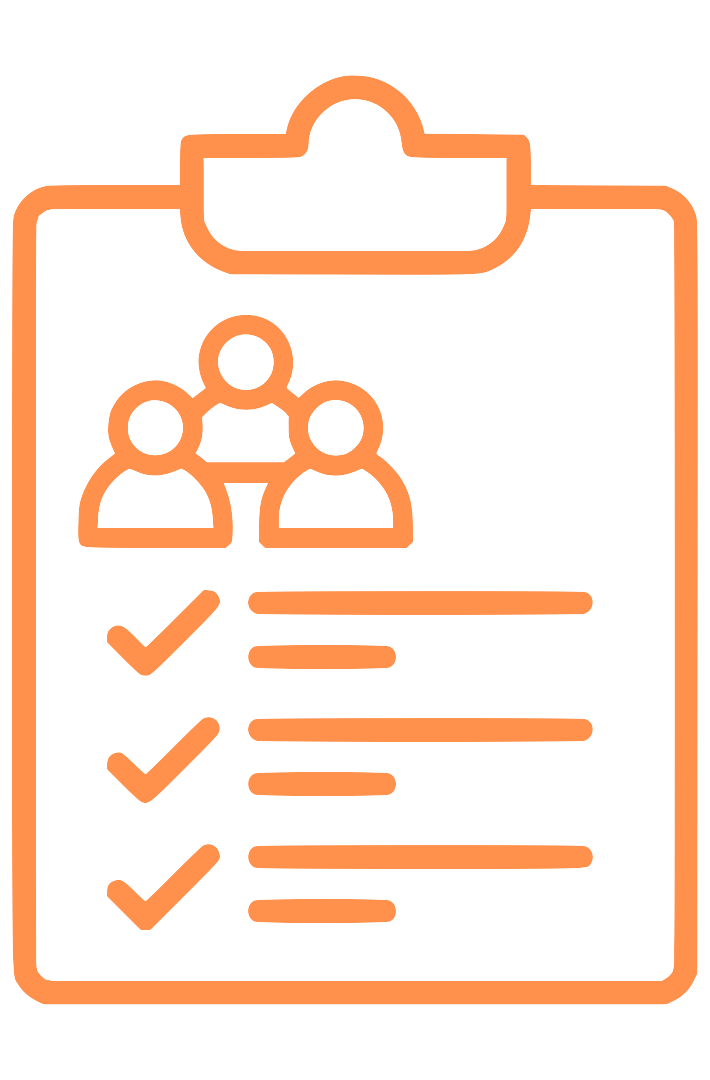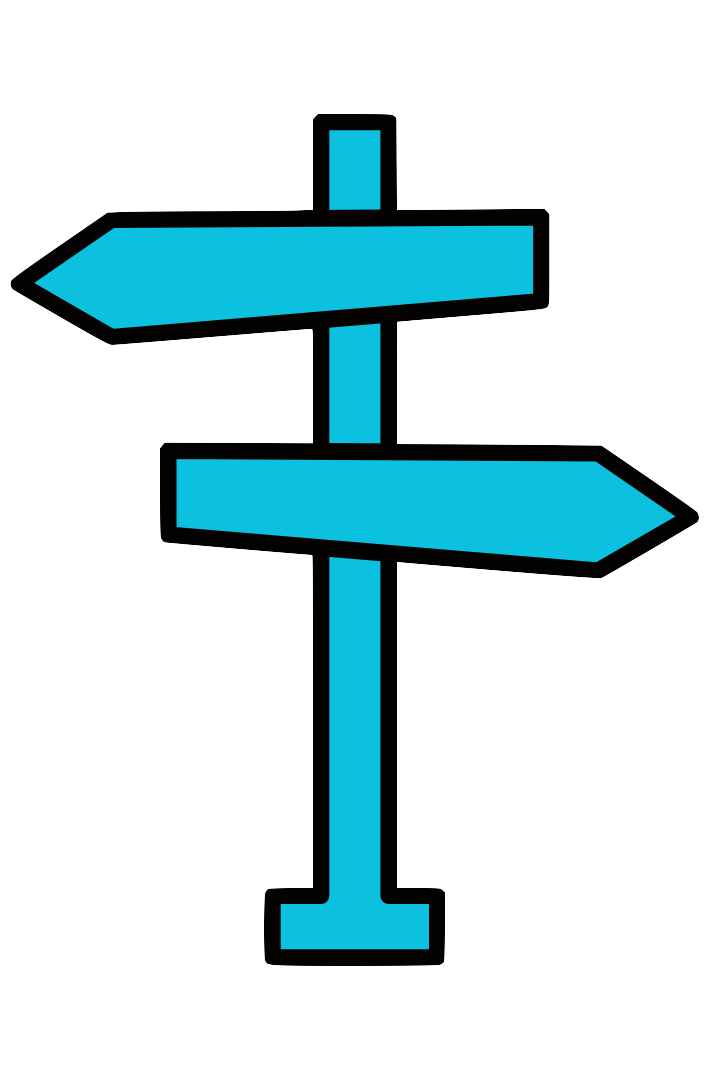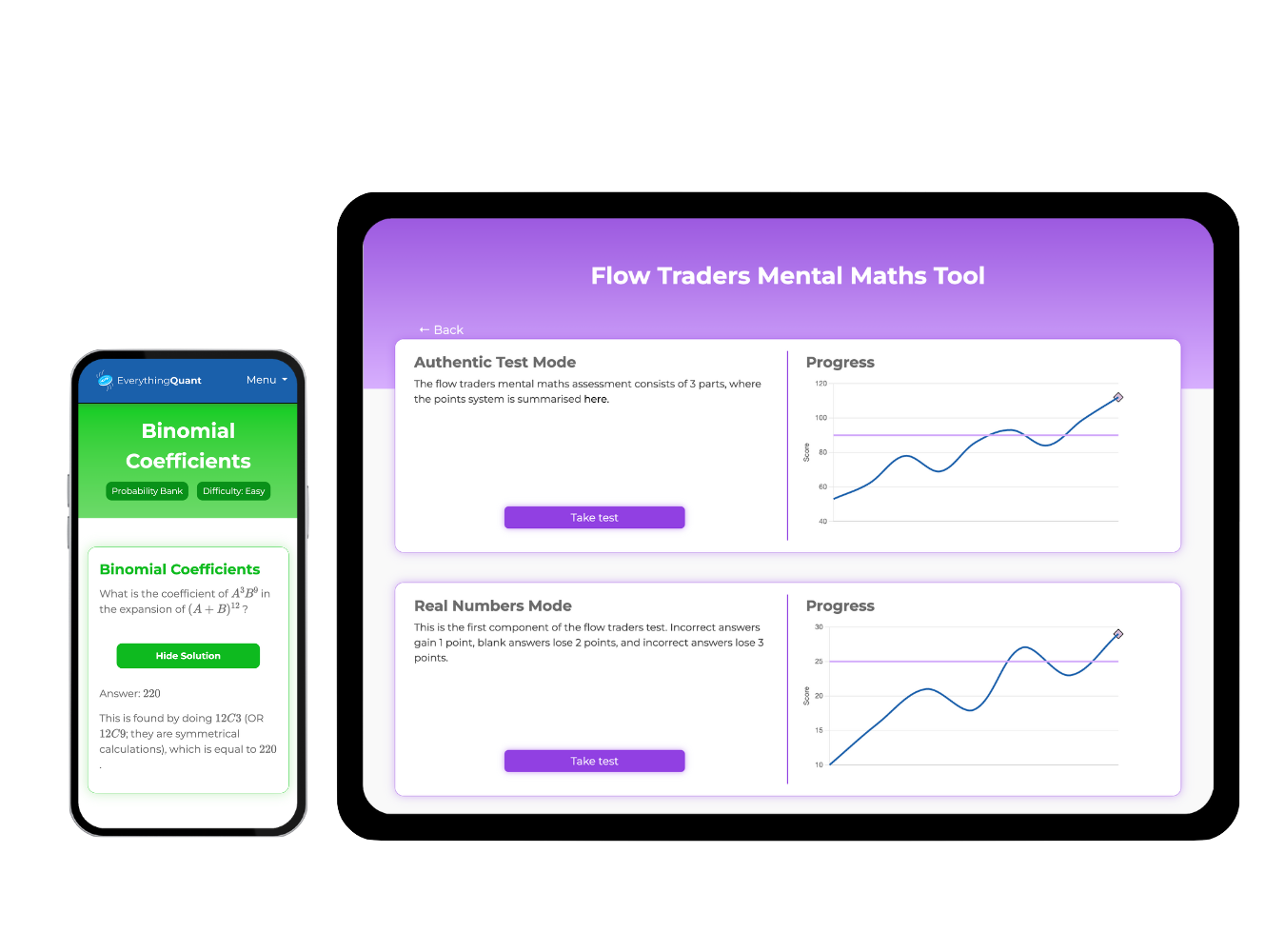How To Ace Any Quant Interview
In this article, we provide you with a practical guide to quantitative finance interviews.

Introduction
Working in quantitative finance requires you to solve challenging problems that have real-world impacts. Whether you are a trader, researcher, software engineer, risk analyst, or any other profession in quant finance, you will have to interact with problems that have a probabilistic element, and may not have a straightforward solution.
Navigating such an uncertain and open-ended environment is a skill in itself, a skill that is sought out by many quant firms around the globe. However, inspiring creative solutions to problems is not a skill that someone is born with; it is the result of mastery, consistency, understanding key tricks, and experience.
In this guide, we will dive deep into how to prepare for technical interviews, share special tips and tricks, discuss the types of questions asked, and, most importantly, explain how to approach technical questions. By studying this, we aim to maximise your chances of securing a quantitative finance job.
Your Background
Quantitative finance firms hire from a range of different backgrounds. Often, you will see people from all different walks of life. However, there are a few key characteristics that quantitative finance firms are looking for. We have compiled a general list of qualities, qualifications, and background you may want to strive for, in order to break into quantitative finance:
Personal Characteristics
- Adaptability and quick thinking: quantitative finance is fast and ever-changing - being able to change and adapt quickly is imperative.
- Strong pattern recognition: Having a strong ability to identify mathematical patterns and trends is crucial.
- Attention to detail: Being attentive and perceptive ensures you are able to make rational decisions.
- Competitive: Experience in high-level competitive environments demonstrates strategic thinking, resilience, hard work, patience, and many more valuable lessons that aid in being an effective quant.
- Quick learning and discerning judgment: The capacity to assimilate large volumes of information rapidly and act decisively is vital.
Background
- Are working toward a Bachelors, Masters, or PhD within a STEM field (Non-STEM majors can still make it, just less likely overall)
- Have foundational knowledge in mathematics, probability, and statistics
- Advanced quantitative, logical, and problem solving skills
- Interest in working in a fast-paced, collaborative environment
Types of Questions
In quantitative finance interviews, you may face a wide range of technical questions. We have listed the main types of questions below:
Probability Questions
Questions that have a probabilistic component typically make up the bulk of your interview process. These questions may require you to calculate expected values, apply conditional probability to situations, recursion, binomial and normal distributions, markov chains, and more.
To practice probability questions that will appear in quantitative finance interviews, we have a comprehensive list of probability interview questions with answers here!
Brainteasers
Brainteasers are a special type of question requires abstract problem solving skills. These questions typically don't have an intuitive answer, or follow any particular formula - they test your ability to be creative, understand an abstract scenario, and find solutions outside of the box.
To practice brainteasers that will appear in quantitative finance interviews, view our comprehensive list of brainteasers.
Risk Management Questions
In quantitative trading, not only is obtaining expected value important, but also your ability to navigate risk. This is to ensure you don't take big losses that could heavily damage your bankroll in short, unlucky bursts.
For example, if you have a trading strategy with a positive expected value but a 10% chance of losing all your money and going bankrupt at any given time, it is not a very good strategy.
Types of questions that encapsulate risk management include Exponential Wins and Shooting Hoops.
Market Making Simulations
In your trading interview, you may be tasked to create a model that participates in a given market at all times, constantly buying and selling, and adapting your prices to ensure you remain profitable.
It is imperative you understand the in's and out's of this market making. View our interactive 'make me a market' game simulations, as well as our market making lesson within our Algorithmic Trading Course.
Random Quick Maths Questions
In your interview, you may be asked a mental maths question out of the blue, to test your reaction skills and your ability to navigate uncertainty.
For example, you may be asked, "What is 7 * 14?", or, "What is the square root of 225?".
It is important that you keep 'on your toes' and switched on in your interview, and ensure that you're ready for anything that comes your way.
How to Answer Technical Questions
Now, the most important part. We will talk about exactly how to answer questions in an interview setting, getting the right information, understanding the question, and finding a solution.
When you face a technical question in a quantitative finance interview, the process of answering is just as important as the final solution, if not more. It is absolutely critical to approach each question systematically while demonstrating your communication and critical thinking skills.
1. How to Prepare
In order to become an expert at solving questions that will appear in quantitative finance interviews, you must have a very good grasp of the concepts that will appear. Such concepts include expected value, probability distributions, counting, conditional probability, random walks, markov chains, mathematical optimisation, and more.
To assist you in mastering such topics, we have created a course in probability for quant finance interviews, which specifically targets every probability concept that you will encounter within a typical quant interview.
2. How to Focus
This may seem very fundamental, however several candidates fail to adequately focus in on the questions asked in quant interviews. This is because some questions may be difficult to understand at first, require several steps, and are intentionally left open-ended.
The most important thing you can do when the question is being explained is to be fully present, while writing down important details.
3. How to Ask the Right Questions
A secretive strategy that firms employ in interviews is purposefully leaving out essential information, making questions difficult to understand. This places the responsibility on you to ask the right questions to fully piece out the problem.
When asking questions about the problem, you want to have a complete understanding of the situation that the interviewer has described. If there is any vagueness within the problem, ask questions which makes the problem as specific as possible. If the interview is a game-style question, you could ask for an example demonstration of said game.
Once you believe you have enough information to solve the problem, or at least know all dimensions of the problem, reiterate all components of the problem to your interviewer. The interviewer is there to help clarify any components of the situation, so discussing the entire problem will ensure you have the question correct.
The most important takeaway here is to ensure that you have sufficient and clear communication between you and your interviewer. This will not only make your interview process easier, but it will enable you to better answer the questions. This is imperative in competitive interviews.
4. How to Find a Solution
Now, the difficult part. In your interview questions, you may be required to find an pinpoint solution that is either right or wrong, an optimal solution based on strategy and expectation, or a solution that is completely open-ended and has no correct answer. This makes navigating the interview process difficult.
We have compiled all of our particularly important strategies to solve problems in interviews below. After this, we will go through some examples that highlight how to go about using these strategies:
1. Communicate your thought process: Perhaps one of the most important things you can do when trying to find a solution to a problem is communicate your thought process to your interviewer. This not only allows the interviewer to understand how you think, but also allows you to flow through ideas and come up with better solutions to your problems.
2. Embrace mistakes: Do not feel demotivated if you make a mistake in the process of solving the problem. Everyone makes mistakes - even the most experienced quants. You can make this easier by treating your technical interviews as a partnership instead of an examination. Remember - the interviewer is on your side!
3. Negate the question: Some questions are just easier to solve by finding the opposite of that question first. This is especially important in questions that require combinatorics and advanced counting techniques.
4. Start Simple: If the question requires some sort of optimisation or strategy, begin with the most simple, fundamental strategy, and build from there. You may come to find that starting on simpler ideas enables you to think bigger, like stepping stones. So don't rush into the most complex solutions at the start of your optimisation and/or strategy questions!
5. Break up the question: If you are dealing with a question that requires significant computation, or appears advanced, try breaking down the question into smaller parts. You may find trends in the answers which enables you to generalise, and come up with a solution easier.
6. Understand trade-offs: For particular open-ended questions, understand what your trade-off is. For example, it could be a tradeoff between expected value and risk; you may formulate a strategy that has a high expected value, but carries huge risk. Your job is to find the optimal trade-off between the two variables, and most importantly, justify why you choose that trade-off.
Now, in the next 3 examples, we will demonstrate this entire process.
Example 1: Birthday Paradox
Let's say your technical interview with this question:
There is a room containing 25 people at random. Your friend bets you $50 that someone shares a birthday in that room. What is your expected value?
Intuitively speaking, you will understand that this question will require some calculations regarding expected value and probability, perhaps combinatorics. However, you may want to ask clarifying questions here, since some components are left relatively vague.
Clarifying question 1: "So when you describe that someone shares a birthday in the room, does that condition also allow for 3 people sharing 1 birthday? What about 2 pairs of people sharing birthdays on different dates? Does this continue for all possible combinations of people sharing birthdays with each other?"
Interviewer: "Yes, that is correct. Within all 25 people, if you have at least 2 people that share a birthday, for any birthday, the condition is satisfied, and you lose the bet."
Clarifying question 2: "On the condition that my friend 'bets me $50', does that mean that my friend places a $50 bet for someone sharing a birthday in the room, I place a $50 bet that no-one shares a birthday in the room, and the winner takes all of the money?"
Interviewer: "That is correct. if someone shares a birthday, your friend recieves your $50 and keeps their $50. If no-one shares a birthday, you receieve your friend's $50 and keep your own $50."
Here, instead of assuming core parts of the questions, you are clarifying such open-ended parts of the question with your interviewer, ensuring you are both on the same page, and you fully understand the question. Now we know exactly what condition satisfies for the bet, and how much the bet is worth on either side of the deal.
Now, you can begin to formulate solutions to this question. You may describe the following to your interviewer:
Thought Process: "We have two options to figure out this problem: The first option is to find the probabilities of exactly 2,3,4...25 people sharing the same birthday, in addition to 2, 3, 4, ... 12 pairs of people sharing different birthdays, and all the consequential combinations of the above, sum up all the probabilities and find the solution. The second option is to simply find the probability that nobody shares a birthday. At face value, the second option seems much more reasonable, so I will start with finding the probability that nobody shares a birthday."
In this case, you have identified that solving the problem directly, as per the phrasing of the question, would require far too many calculations, and an easier way would simply to calculate the opposite by negating the question. Now, you can go on to solve the problem:
Solving: "So we have 25 people in a room, which will require significant computation. Let's start by assuming the room has 2 people; the chance that they would not share the same birthday is 1 * 364/365 = 0.997, since the second person has 364 birthdays to choose from. Now, let's say there are 3 people in the room; the chance no-one would share the same birthday is 1 * 364/365 * 363/365 = 0.992 - This is because the first person can choose any of the 365 days, the second person can choose 364 days, and the third person can chooes 363 days, to ensure nobody shares the same birthday."
You have successfully broken the problem down to it's fundamental components, and found a pattern within the problem. Now, you can generalise this problem and solve:
Solving, part 2: "We can generalise this for n people in a room: 1 * 364/365 * 363/365 * ... * (365-n)/365 = (365 * 364 * 363 * ... * (365 - n + 1))/365^n. The numerator is simply the the product of the first n terms from 365 to 365 - n + 1, so we can generalise to (365!) / (365 - n)!. Therefore, substituting n = 30, we have a ((365!) / (335)!)/365^30 = 0.294 chance of nobody having a birthday."
Congrats! You have found the probability that nobody shares a birthday, and in the process you found a formula that could find the chance of nobody sharing a birthday in a room of n people. Now, don't forget to substitute this back into the bet:
Solving, part 3: "Now, we find the expected value of the bet with my friend: E[X] = 0.294 * 50 - (1 - 0.294) * 50 = -$20.6. Therefore, we would expect to lose $20.6 from this bet."
Through this example, to summarise, you asked clarifying questions, understood you had to negate the problem, broke the question into smaller parts, found a general solution, and solved the problem accordingly. Given you made any mistakes in the process, your interviewer would let you know.
Example 2: Dice Game Optimisation
Now, after passing the previous question, your interviewer challenges you with this:
You have an unbiased 30-sided die, and 100 moves. The die starts on the side with 1 on it. You can choose to re-roll the die, which takes 1 move, or take money which is the face value of the die, which takes 2 moves. An example of how this could play out is: You re-roll the dice, using 1 move, and it lands on 13. You choose to take money, which takes two moves, and you recieve $13. You have 97 moves left. How can you extract maximum profit from this game?
This set up is a game that requires to find a maximum value, which indicates that there will be optimisation, strategy, and probability involved. Before we jump into possible solutions, let's just make sure we completely understand the game:
Clarifying question 1: "When we have a situation, such as, the first roll is a 30, and we have 99 moves left. Can we keep cashing out the 30 x 49 times, until we reach 1 turn left?"
Interviewer: "That is correct. At any point within the game, you have the option to cash out the face value of the dice from the last roll, or re-roll. Again, re-rolls cost 1 move, and cash-outs cost 2 moves."
So now that we have clarified the game, we can think of strategies to employ. As we described in the above segment, what we can do is start with simple strategies, before going to more advanced ones.
Solving: "I will use expected values to find the best strategy on average. Let's start with a simple strategy - let's wait for a 30 to be rolled, and then continuously cash out until our moves are finished. The odds that a 30 would be rolled on a 30-sided dice is 1/30, meaning it would take, on average, 30 rolls to achieve. Now, we have 70 moves left to cashout $30. However, each cashout takes two moves, so we would redeem 70/2 * 30 = $1050."
Here, you calculated the expected value for your initial strategy. Now, it's time to build on this strategy!
Solving, part 2: "This is a good start, however, if we increase the stopping condition to cash-out, we can reduce the expected number of rolls we must perform at the start. Let's stop once we get a 28, 29, or 30. The expected number of rolls we would need is 30/3 = 10, the expected roll we would get is (28 + 29 + 30)/3 = 29, and thus our expected score would be 90/2 * 29 = $1305. This is clearly an improvement from the previous strategy."
Congrats! You found a way to improve your strategy. Now, you shall go on to finding the optimum stopping condition.
Solving, part 3: "Let's try stopping at 27, 28, 29, 30. Expected number of rolls => 30/4 = 7.5, expected roll is (27 + 28 + 29 + 30)/4 = 28.5, so our expected value is 92.5/2 * 28.5 = $1318.125. Let's try adding 26 to the stopping condition. Expected rolls => 30/5 = 6, expected roll is (26 + 27 + 28 + 29 + 30)/4 = 28, so our expected value is 94/2 * 28 = $1316. Therefore, we have found the optimal strategy -> rolling until we receive a 27, 28, 29, or 30, and continuously cashing out from then."
This problem effectively demonstrates how to utilise optimisation and strategy problems - start with simple solutions, and then make your way up to more effective ones.
Example 3: Asymmetric Bet
For your final test, you are given the following question:
You are playing a casino-style game where you have $100 total, and you can bet any amount on a coin landing on heads. If the coin lands on heads, you receive back 2.5x the amount you bet (i.e. 1.5x your bet in profit). If the coin lands on tails, you lose your bet. You flip the coin 50 times. Firstly, what is the betting size that optimises the amount of return in this situation? Secondly, would you employ this betting size? If not, how would you go about playing this game?
We are provided with a relatively simple premise, however, we should ask questions to clarify:
Clarifying question: "So, let's say I bet $10, and lose the bet, then I bet $10, and win the bet. Does that mean my PnL will be -$10 + $15 = $5?"
Interview: "Correct. You gain 1.5x your betting size in profit when you win, and you lose 1x your betting size when you lose."
Now that you fully understand the rules of the game, let's see if you can work out how to solve this problem:
Solving: "Let's denote n as the amount that we bet per round. We have a 50% chance that we win each round. Therefore, our expected value is given by: E[X] = n(0.5 * 1.5 - 0.5 * 1) = 0.25n. Therefore, to maximize our expected value, we should bet the largest possible amount. Therefore, we should bet 100% of our total amount every round to maximise expected value."
Great! As per the question, you have correctly identified the betting size which ensures the highest expected returns. However, the next question, 'would you employ this strategy' is slightly more difficult to answer.
Solving, part 2: "Employing this strategy appears to realistic at face value, since you have a 50% chance of losing your entire bankroll every round. We can calculate the odds of us losing money, by taking the odds of us winning a round, to the power of the total number of rounds: (0.5)^50 = 0.000000000000000088817842. Therefore, this strategy is basically impossible to generate a profit from. The optimal solution will come from a trade-off of expected value and reward. Let's take 50% bankroll, for example. Assuming our bet's lower limit is 1 cent, we can find how many more losses than wins we need in order to lose it all: 0.01 = 100 * (1/2)^x = 13.3, which is 14 losses to lose it all. This seems much more likely to not lose it all, when compared to betting 100% of the amount.'
Here, a useful risk metric is calculating the odds of profit. However, you can also calculate other metrics, such as variance. Further, we proposed a 50% bankroll amount to bet each time, which reduces risk substantially.
Closing Remarks
We get it. Quantitative finance interviews are daunting. However, if you deeply understand the concepts taught in this guide, mastery the foundational probability required, and practice consistently, you will maximise your chances of landing a quantitative finance role.
To gain an advantage in the interview process, it is imperative that you start preparing early and stay consistent in your preparation. Many applicants fail to delegate adequate time for interview preparation, or overlook interview preparation in general, leading to failing throughout the interview process.
For competitive jobs, interviewing is a must-have skill. Please understand, quant is a competitive industry, with only a select few that will fill in positions. To stand out, and maximise your chances of securing your dream position, you must prepare early.
For additional resources for quant interviews, view our Probability for Quant Finance course, along with 150+ high quality brainteasers and probability interview questions for technical interviews.




























